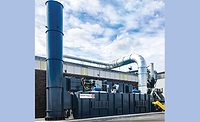Clean and Green PSAs
Pressure-sensitive adhesives offer the benefit of having low to no VOCs.






Fears and concerns about volatile organic compounds (VOCs) have become more prominent in recent years—although they have been around for decades. For example, many types of pressed wood contain formaldehyde, a known carcinogen that releases chemical fumes into the air for many years. In addition, in the 1970s, it was common for homeowners to install urea-formaldehyde foam insulation (UFFI) to save energy. A substantial number of these homes had high levels of formaldehyde in the indoor air soon after installation, according to the U.S. Consumer Product Safety Commission.
Statistics show that “off-gassed” VOCs can result in a plethora of both short- and long-term adverse health effects, while also posing a number of environmental concerns—from indoor air quality to ground-level ozone formation. According to the Minnesota Department of Health, the toxicity and health risk of VOCs depends on each specific chemical, how much out-gassed chemical is in the air, and how long and how often a person breathes it in.
Obviously, VOCs should be avoided. Today, many converters and manufacturers pay close attention to the materials used in their end products in order to help ensure that the products are safer and healthier for consumers; these include pressure-sensitive adhesives (PSAs).
VOCs in Adhesives and Sealants
Industrial PSA tapes are used in thousands of applications in various markets—such as foam and gasket fabrication, appliance, automotive/transportation, nameplate, construction, and electronics—and have the potential to emit VOCs. When it comes to regulating adhesive- and sealant-related VOCs, rules governing use are aimed at maintaining air quality by reducing or eliminating VOC out-gassing. As noted by the Adhesive and Sealant Council, out-gassing often occurs when VOCs in adhesive and sealant products react with nitrogen oxides in the air in the presence of sunlight.
To date, there is no commonly followed international or national VOC standard for adhesives and sealants. However, the U.S. Environmental Protection Agency (EPA) has a rule in place that mandates VOC limits for a range of consumer products, including adhesives and sealants, and has developed a control technology guideline to assist states or local air pollution control authorities in developing approaches for controlling VOC emissions from miscellaneous industrial adhesive application processes.
Most commonly, rules and regulations for VOCs in adhesive and sealant industrial product constructions are specific to the industry or, in many cases, the original equipment manufacturer (OEM). For building materials and electrical and electronic equipment, for example, Japan Industrial Standards (JIS) specifies measuring methods of VOC and aldehyde emission under the assumed temperature, humidity, and ventilation for indoor environments.
In the automotive industry, each major auto manufacturer—from General Motors, Chrysler and Ford to Nissan, Toyota, Honda and beyond—has developed VOC compliance standards for adhesives and sealants used in the vehicle manufacturing process. Toyota’s known test method for VOC analysis is TSM 0508G; the common European test method for VOC and fog emissions is VDA278. General Motors uses GMW15634 for VOC analysis, which is a detailed, technical test in which a laboratory isolates specific nonmetallic interior components like carpet, lacquer, adhesives, foam materials, leathers, plastic parts, or combinations of different materials. According to the Handbook of GC-MS: Fundamentals and Applicationsby Hans-Joachim Hübschmann, the lab conducts semi-quantitative tests to measure the emission of VOCs and semi-volatile organic compounds (SVOCs) or condensable substances (i.e., fog).
Auto manufacturers or component suppliers often work with organizations such as Intertek, which tests, inspects and certifies products to ensure they meet quality, health, environmental, safety, and social accountability standards. Intertek provides VOC and aldehyde-ketone emission testing for materials and products. It captures and identifies gaseous VOC constituents emitted from test samples, and provides a summary of the VOCs analyses so that an engineering judgment can be made as to the usability of the material.
With increasing regulations and stricter specification guidelines for the presence of VOCs in industrial adhesives and sealants, converters and OEMs need to partner with a reliable technical PSA supplier that can produce product solutions to effectively meet their needs while guaranteeing a sustainable, environmentally friendly outcome.
Going 100% Solids
To meet industry and market demands for greener, cleaner adhesives, converters and OEMs should seek a PSA supplier that specializes in 100% solids adhesive coating technology. This adhesive coating technology uses a 100% solvent-free coating method and can be applied to both acrylic- and rubber-based adhesive systems.
In comparison, other common PSA coating technologies include emulsion acrylic adhesives and solvent adhesives. With emulsion acrylic coating, the PSA is dispersed in water to achieve a coatable viscosity. With solvent coating, the PSA is dissolved in a solution of VOCs until a coatable viscosity is achieved.
The problem with solvent coating techniques in relation to environmental sustainability is they do not guarantee a VOC-free adhesive solution. What’s more, the manufacturing processes are more extensive than that of the 100% solids method.
Emulsion and solvent coating technologies require long,
gas-fired ovens to drive off the water or the solvent. Line speeds tend to be slower because of EPA and Occupational Safety and Health Administration (OSHA) regulations. In addition, specific to solvent-based PSAs, product cost can be unstable as the cost to produce solvent PSAs is directly related to the cost of petroleum.
100% solids coating technology offers clear environmental and economic advantages. Adhesives are rubber based (also known as hot melt) or acrylic based. With hot melt, the adhesive is heated to reduce viscosity then melted into a coated, molten form. In the case of acrylic, adhesives are a lower molecular weight and coated at room temperature (or slightly elevated temperature) using UV or electron-beam radiation to cure the adhesive.
Along with delivering ultra-low levels of VOC out-gassing, migration and residuals, 100% solids adhesives offer:
• Excellent optical properties
• Adhesion performance typical of traditional solvent acrylics, with a superior balance of adhesive properties
• Inert and non-fluorescing features
• Adhesive thickness greater than 5 mils, if needed
• A wide temperature range and high-temperature resistance that is better than solvent acrylics (up to 425°F)
• Precise deposition control
• Excellent solvent, chemical and plasticizer resistance
In addition, 100% solids adhesives tout an extremely efficient and cost-effective manufacturing process. For example, the cost of natural gas or petroleum for production is eliminated, as ovens are not required. In addition, retained solvents do not need to be measured in order to meet EPA regulations, thus enabling faster line speeds—and delivering the customer a greener product at a more stable price with consistent product availability.
For more information, visit www.mactac.com.
Choosing a Technical Adhesives Supplier
In addition to ensuring an adhesives supplier can produce product solutions with low to no VOCs, when choosing a technical adhesives partner, converters and OEMs should make certain their supplier:
• Can formulate customizable adhesive solutions specific to application need
• Has a dedicated and knowledgeable sales staff, technical support team, and research and development department that focus on the customer experience
• Features a variety of carriers and a broad base of materials with the capability to produce small sample rolls
• Pretests materials to ensure they pass specifications and meet product performance standards
Looking for a reprint of this article?
From high-res PDFs to custom plaques, order your copy today!







